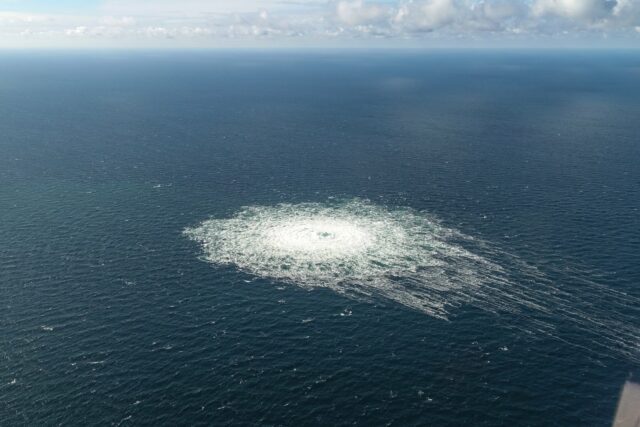
Sabotage of Nord Stream Pipelines and Gazprom Policies Fuel Gas Fears in Europe
Publication: Eurasia Daily Monitor Volume: 19 Issue: 145
By:

At the end of September 2022, four separate leaks were reported on the Nord Stream One and Nord Stream Two pipelines (Svd.se, September 29). Based on preliminary evidence, the damage was deemed to be caused by deliberate acts of sabotage and not resulting from natural factors or ordinary accidents. One of the most logical explanations of the attack on the pipelines is that it could be the work of Russian saboteurs, who wanted, among other motivations, to manifest their ability to destroy energy infrastructure in Europe. Moreover, the sabotage corresponds with the simultaneously undertaken decisions of Gazprom, which is further cutting down its supplies to European customers (e.g., Italy’s Eni and Moldova) (T.me/Gazprom, October 1).
Out of the four leaks reported, two happened on the Nord Stream Two twin-pipeline (on the same pipeline string) and the remaining two on Nord Stream One (on two different strings) (Ens.dk, September 29). The scale of gas leaks was so large that, on the very first days, it was impossible to perform proper inspections; however, footage from the air and data recorded by seismologists leave no doubt that the damage was caused by powerful explosions. According to Denmark’s and Sweden’s joint letter to the United Nations Security Council, the blasts could have been caused by an “explosive load of several hundred kilos” (Twitter.com/AnnLinde, September 29). Furthermore, the Danes estimate that, as a result, the whole volume of natural gas contained in the three pipeline strings could be emitted (as much as 778 million cubic meters) (Ens.dk, September 29).
Despite limited information, it seems crystal clear that the leaks happened as a result of deliberate, hostile action due to the number and scale of explosions. More importantly, however, one should understand that, undoubtedly, it is also a manifestation of power, as the perpetrators (whoever they might be) definitely wanted it to look like a full-scale act of sabotage. Keeping all this in mind and taking into account the current energy situation in Europe, no logical explanation could possibly suggest Western countries, or Ukraine for that matter, as the perpetrators. Therefore, the Russian Federation must be seriously considered as a suspect (especially, as such an attack would require the capabilities that only a state actor possesses).
Importantly, the sabotage had no critical, direct impact on the European gas market, as both Nord Stream One and Nord Stream Two had not been supplying any natural gas to the European Union in recent months—as Gazprom halted Nord Stream One gas flows a few weeks ago and Nord Stream Two was never officially launched. Nevertheless, the explosions have undeniably added to fears within Europe in the face of the coming winter, suggesting that other critical continental energy infrastructure could also be targeted in the near future, including the Baltic Pipe connecting the Norwegian Continental Shelf with Poland via Denmark, which was officially opened on the very same day that the first Nord Stream blasts were reported (Gaz-system.pl, September 27).
Furthermore, it is also uncertain whether the recent explosions could also affect the SwePol Link (Sweden-Poland high-voltage direct current transmission submarine cable), as one of the blasts took place only 500 meters away from it (Pap.pl, September 29). When the blasts were triggered, the cable had been undergoing pre-scheduled maintenance. Thus, no public market data is available to prove whether the explosions have interrupted energy flows. If the sabotage did indeed damage the cable, then it will create an additional challenge for the Polish energy system, as the SwePol Link is used for imports at times when the energy generation in Poland cannot meet the demand.
Last but not least, it is also crucial to understand the extent to which the sabotage of the Nord Stream pipelines coincided with other recent hostile decisions and announcements from Gazprom. First, on September 27, the Russians made it clear that they will sanction Ukraine’s Naftogaz (which is party to the transit agreement) if the Ukrainian company will not abandon its arbitration proceedings against Gazprom (T.me/Gazprom, September 27). The demand was turned down by the Ukrainians almost immediately, and this might be used in the near future as a pretext for Moscow to halt gas transit through Ukraine to Europe (Naftogaz.com, September 28). Second, Gazprom has also stopped deliveries to Italy through Austria, reduced exports to Moldova (T.me/Gazprom, October 1) and cut gas flows to Europe via TurkStream (1prime.ru, October 1). Effectively, all this suggests that, in the coming weeks, the Kremlin might halt most of the remaining supplies to European customers (except possibly Hungary and Serbia).
As for now, we still do not know what the proper investigation will bring; however, the Swedish prosecutors do believe it will be possible to successfully trace the perpetrators (Aftonbladet.se, October 1). The new evidence, including underwater footage of the pipelines, should come fast, as the outflow of natural gas from the damaged Nord Stream strings has already stopped (Radio Free Europe/Radio Liberty, October 2). By now, one can only guess what will be the Russian reaction if the future verification will indeed prove Moscow’s involvement in the sabotage of the pipelines.



